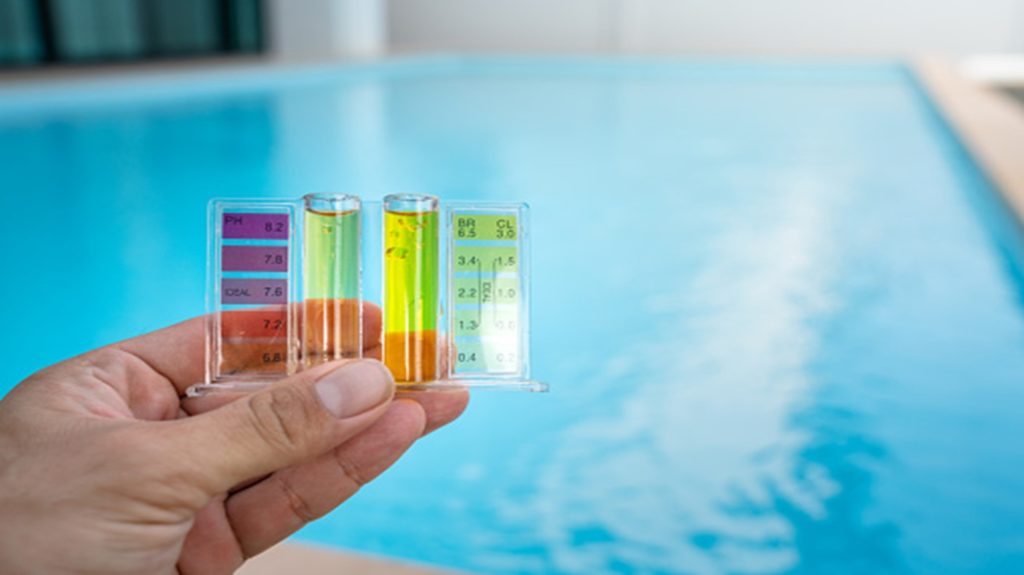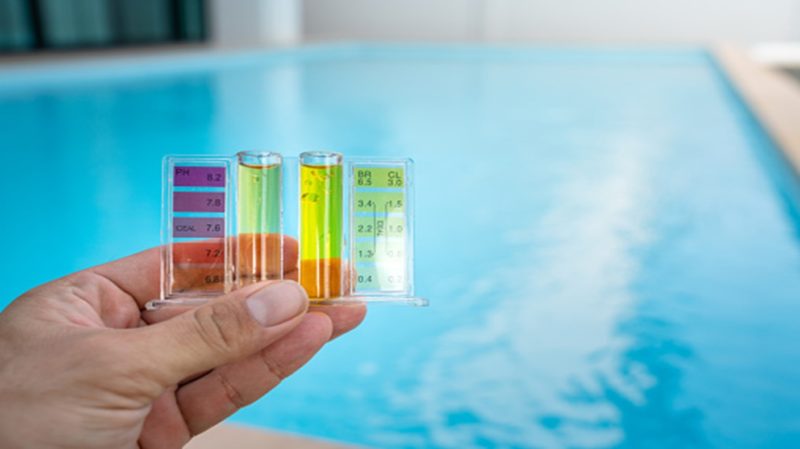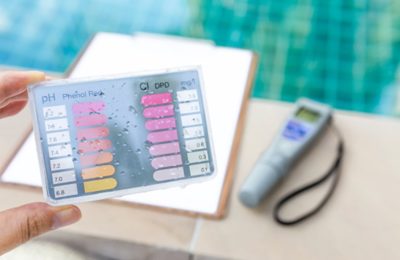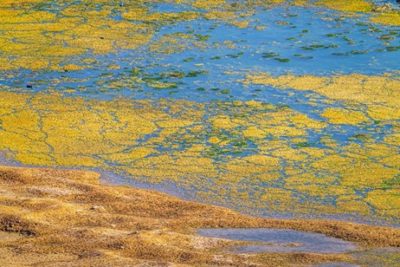Swimming pools can be a great addition to your homes if you’re a fitness aficionado. Swimming pools can also be just great for hosting pool parties and cooling off the summers by taking a dip in them. However, if left unattended, even chlorinated pools can develop algae – you don’t want that!

The wretched, disgusting muck that you see at the bottom of your swimming pool is not only an unpleasant sight but also clouds your swimming pool water. This makes your swimming pool unfit for swimming, because after all, who’d want to swim in a dirty pool (not to ignore the health consequences)?
No matter how much sanitizer you add to your swimming pool, you won’t be able to cut down the growth of algae inside your pool. And before you know it, it’d have spread to every corner of your swimming pool. Therefore, any number of green algae in the pool must not be neglected and dealt with as soon as possible.
What are green algae?
Chlorophyta are microorganisms that belong to the kingdom Protista. The microorganisms are plant-like in that they can generate energy from sunlight. Green algae are another name for these microorganisms.
Chlorophyll gives green algae their color. Green algae float in the water, discoloring it and giving it a greenish tint. Slimy green algae will also attach themselves to the walls and floor of your pool. Green algae development is aided by poor filtering and a lack of adequate sanitization. It can enter your pool through swimsuits and toys that have been used in algae-infested natural bodies of water.

On a day full of sunshine and bliss, algae photosynthesize and reproduce quickly, quickly turning your tiny problem into a pool-sized one. It’s easy to overlook a slight cloudiness or some stubborn, black marks near your steps, especially if your pool is often used.
Algae may obscure and discolor the water, making rescue operations more difficult and decreasing a diver’s depth perception. Algae is not dangerous to swimmers in and of itself, but algae-infested pools may provide a safe haven for diseases such as E-coli bacteria.
Algae blocks sanitation routes in the water and clogs the pores in a pool filter, reducing filter efficiency and necessitating additional backwashing or filter replacement.
It may lurk deep within the cracks of a filter, as well as in rough areas on pool plaster and tile, as well as behind the pool light and beneath the ladder treads. Some pool algae strains will shoot roots into the plaster, eventually degrading and staining pool surfaces.
Algae consume chlorine that should be acting on other pollutants by creating a chlorine demand in the water. The pH of pool water can rise when it expels carbon dioxide.
Algae are similar to weeds in the garden. Unwanted, unsightly space invaders add to the gardener’s workload and deplete nutrients and resources from the flora we want to grow.

Other types of algae that may infest your swimming pool
Green algae in the pool are by far the most common algae problem that you might come across. However, there are also other types of algae that might be infesting the clear waters of your backyard swimming pool.
Black Algae
Technically a cyanobacterium, this wicked microbe produces its own nourishment, allowing it to grow and expand. Furthermore, its roots burrow into concrete surfaces, making it difficult to eradicate black algae in your pool. If your treatment isn’t severe enough to guarantee that none of the roots remain, it will regrow fast.

Mustard Algae
If you notice what appears to be pollen or sand in a shaded part of your pool, you most likely have mustard algae. It’s also known as brown algae or yellow algae. It is uncommon and not slimy like green algae. It’s also chlorine-resistant, making it difficult to treat under any name.

What causes algae to form inside your swimming pool?
Algae are stubborn microorganisms and form in just any body of water in which they can find suitable living conditions. Algae spores are continually introduced into the pool by wind, rain, or even infected swimsuits or pool cleaning gear.
An algal bloom may happen in a couple of hours if the conditions are correct. Out of balance water, warm temperatures, sunshine, and the presence of nitrates, phosphates, and/or carbon dioxide are examples of these circumstances. Pool algae are often caused by a lack of adequate circulation, filtration, and sanitation.
Algae are living water creatures that proliferate fast on warm, bright days. Algae uses photosynthesis to grow because it has chlorophyll. In other words, they absorb carbon dioxide and emit oxygen as a byproduct. Algae can grow in both the shade and the sun, although most pool algae types require some light to thrive.
Algae require food to thrive, and there is no shortage of good food for algae in a swimming pool. Almost any pollutant or windblown dust particle can feed pool algae. Algae has a buffet of healthy food in pools with a high bather count or pools with high amounts of detritus or dissolved particles. Future generations of pool algae can even feed on the dead cellular remnants of past algae blooms.
Algae of tiny size are always found in swimming pools, even in the most pristine, blue pools. It patiently awaits the chance to blossom — when the chlorine level drops and the pH rises or when the pump or filter fails to function correctly.

Preventing green algae in the pool
If you haven’t got an algae problem yet, it doesn’t mean that you never will. You should always take measures to prevent the birth and spread of algae because there’s no stopping it once it starts blooming.

- Make sure that your swimming pool circulation system is running fine.
- Regularly add pool sanitizers.
- Regularly check your skimmers and pump strain baskets to see if they are overloaded.
- Shock your pool once every 7-10 days.
- Regularly scrub and brush your pool.
- Use a pool vacuum to clean the pool water.
- Use an algaecide to prevent algae from growing in the first place.
How to eliminate green algae in your pool?
Green algae are a curse to swimming pools; here’s what you do to get rid of green algae in your swimming pools.
1. Brushing the walls of your pool
Being infested with green algae, you must have already added bottles full of sanitizers to clean it. What you need to do next is, scrub off the green algae from the walls and floor of your swimming pool manually. This helps your swimming pool sanitizer reach greater depths and spaces previously covered by the green slime.
While you’re at it, make sure you give a powerful scrub to the corners of your pool since these are the places that algae adore the most. It will help if you use a sturdy and bristly brush while cleaning your pool.

2. Vacuuming your swimming pool
Your automatic filters won’t filter out the algae for you; you’d have to do it on your own. Lucky for you, pool vacuum cleaners exist, and you can easily vacuum out the nasty greens using them.
Manually vacuuming a swimming pool for algae doesn’t only suck out green algae in the pool but also cleans other debris and sludge that might have settled at the bottom of your pool. This also helps your pool sanitizer to reach crevices that were previously inhabited by green algae.

3. Testing your pool water frequently.
One way to combat algae growth in your swimming pool is by not letting it grow in the first place. You can easily do so by making your pool environment not a happy place for green algae to thrive. We advise you to test your swimming pool water frequently so that it isn’t anywhere near an inhabitable place for algae.
You can use test strips, digital kits, and liquid kits to test your pool water. These bad boys will help you in determining the pH level of your pool water. A higher pH between 7.8 and 8.0 wouldn’t allow algae to grow. Also, now that your pH levels are anti-algae, this helps your pool sanitizer to work wonders against the existing algae.

4. Shocking your pool with green algae
If any of the above methods haven’t worked for you, perhaps it’s time to ‘shock’ your swimming pool. Shocking a swimming pool is considered a last resort.
The act of adding chlorine or non-chlorine pool chemicals to the water in order to increase the ‘free chlorine level’ is referred to as ‘shocking.’ The objective is to elevate this level so that pollutants like algae, chloramines, and bacteria are eliminated.
On the market, you can find many calcium hypochlorite shocks that might do the job for you. There are different types of shock treatments available for different types of algae.
To shock your swimming pool, it would be best if you did it after daylight hours. If you do it at night, our hot star (sun) will consume the chlorine before it reacts against the algae.
While using a calcium hypochlorite shock, spread the entire contents of the shock into your swimming pool. If any granules sink to the pool’s bottom, use a brush to distribute them. When the filter pump is running during the evening hours, add the appropriate dosage of this product.
Time to filter out the algae
When you’ve successfully shocked your pool, you’ll see a foggy blue tint to your pool’s waters. This is all part of the process, and there’s nothing to worry about. What you can do now is turn on your filter and let it clear the water for you. By morning, you’ll see that your pool has cleared up, there’s no green muck, and everything is as it should be.
Readjusting the chlorine levels
After a pool shock, the chlorine levels in swimming pools tend to be high. Now’s the time to test the pH of your pool using test strips. Once the chlorine levels are back to normal, you can have the dive of your life in your (just like) brand-new swimming pool.

Wave goodbye to green algae in the pool
Green algae in your swimming pool can be a nuisance. It is an unseemly sight and repels you away from your swimming pools. However, its bloom can be prevented if you pay attention to pool cleaning and pool maintenance frequently. Even if you don’t, you can always get rid of it by following the tips and methods mentioned above. For now, this is it! We wish you all the luck.
Have a good time getting rid of those nasty green algae in the pool!
FAQs
What naturally kills algae in a pool?
As baking soda may be used as a spot treatment for black algae, home borax can be used to cure blue and green algae. Simply scrape away any algae that have clung to your pool’s walls with the borax, then remove it with the brush.
What chemical kills algae in pools?
A high dosage of chlorine pool shock or granular chlorine will be required to eliminate algae that have grown across more significant portions of the pool or are suspended in the water.
Is it safe to swim in a pool with green algae?
It is not advised, whether moderate or severe. Significant quantities of algae in swimming pools provide a breeding environment for dangerous bacteria that feed on algae. Swimmers are in danger from these germs, which most frequently cause a skin rash. It can also cause bacterial infections in the ears and eyes.
What can I use instead of shock for a pool?
Baking soda will increase the pH and alkalinity of a pool, increasing stability and clarity. Baking soda is found in many commercial goods. Obviously, you’ll need to buy in quantity.






